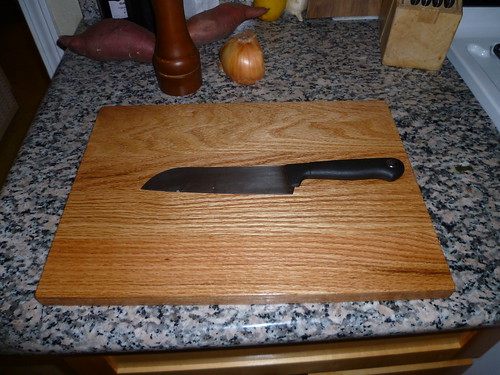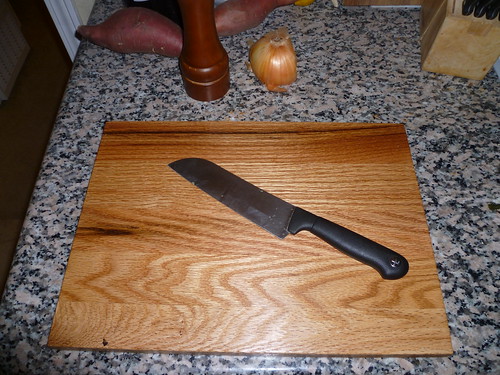A cutting board
2011-12-05
After our trip to Joshua Tree, Jess and I decided that we really ought to have a cutting board in the truck. We already have pots and a stove that live in the car, I just purchased a couple of Mora knives to live there as well (they're on their way).
So, we wanted a specific sized cutting board that would fit nicely into some nook or cranny in the truck boxes that's otherwise hard to use anyway. We were running out to a large hardware store (Lowes) this weekend to grab some things the local one didn't have and Jess asserted that such stores always have planks of good hardwood for reasonable prices. So, (me not believing her) we poked around and sure enough, for $12.00 we found a good sized piece of oak plank, maybe 1" thick, just a bit larger than we needed.
That afternoon I took out our roughcut saw (we have that and a just purchased coping saw, so I figured I'd make it work). I gently sawed through the wood trying to avoid snarls and rough edges as best I could. I cut it such that it would drop behind the left wheel-well (on the camping side of the boxes - the other side is car repair and recovery gear) and slide backwards just a bit locking behind a supporting pillar in the box, so it's totally out of the way.
I then took out a sanding block (we had a couple of foam sanding blocks from cleaning up after moving out of our last place). I sanded the plank for a while until it was starting to feel pretty smooth. Then I switched to a finer grit and did it again. Since it's a cutting board I figured it wasn't worth *really* getting it perfect, so left it at that. By this point it felt and seemed just a bit shiny, but still had some very small pits in it where the grain stuck out.
Next I put on some flax seed oil and spread it about with a rag. It soaked up a huge amount on the first pass, presumably because oak is not a very oily wood (I did this on alligator juniper and it only took in a little). On the second pass that evening it wasn't totally dry yet but close, I added a bit and re-spread what hadn't soaked in. It was totally dry this morning, so I added another coat this evening.
And here's the result:


The last coat of oil isn't dry yet, but I'm pretty happy with it. When it's dry it will look exactly as it does now. Based on the last thing I treated this way it should darken a bit over the next couple of months as it develops that patina wood does (presumably some bit of it oxidizes). When I was treating alligator juniper I was making more of a piece of art, also it didn't take in the oil quickly so I did many many coats. With the oak I feel that the couple of coats I did should be fine - if it starts to look dry some time from now I can just add more.
Anyway - this entire project was a total of a $12.00 plank of wood and between probably about an hour total of work. The result is *exactly* what I wanted in terms of dimensions, since I chose. A cutting board of this size made of wood starts at ~$40 based on the one I got for the kitchen, so saving ~$28 for one hour work is pretty good. Owning something you made always has a different feel to it to.
My only warning is... that much sanding is a pain in the shoulder. If you have a belt-sander this is just a trivial project. Doing it by hand is good exercise though! :D.
I'll try and report back on how well it holds up to chopping some actual vegetables!
Edit:
Tried it last night when chopping apples for apple sauce. It seemed to get less scratched than our commercial cutting board gets.
It's not nearly as smooth as I thought it would be, once the oil dried it feels rough again in some areas - but it IS going in the truck. If it was for the house I'd simply sand it a bunch more.

